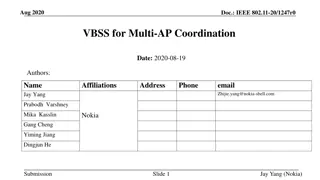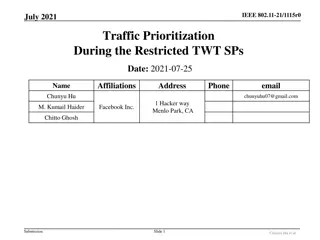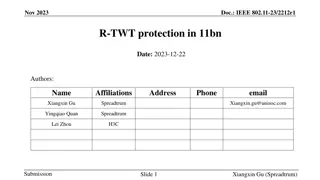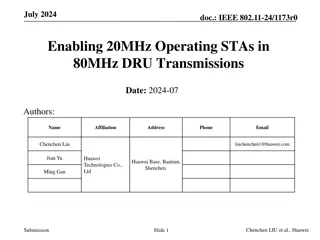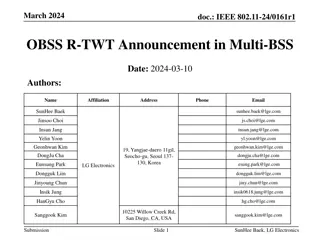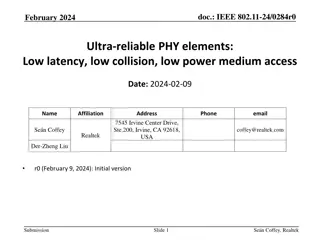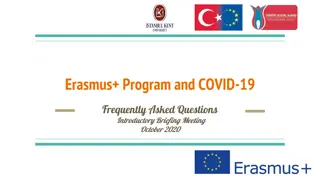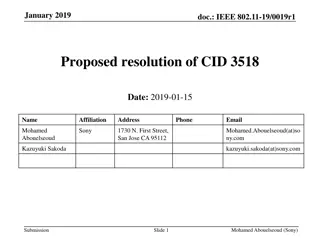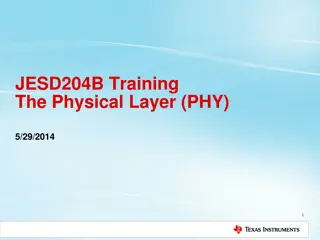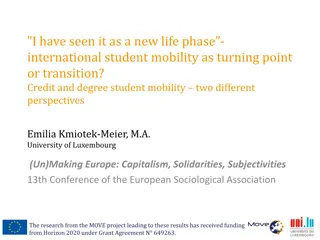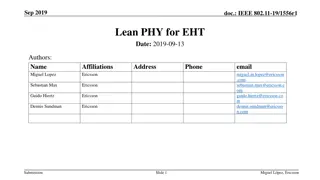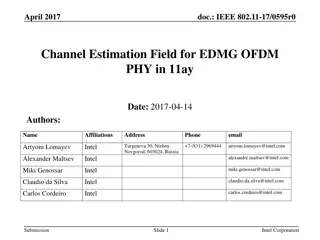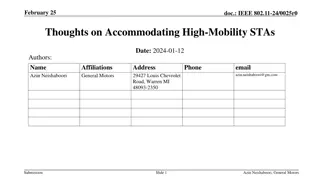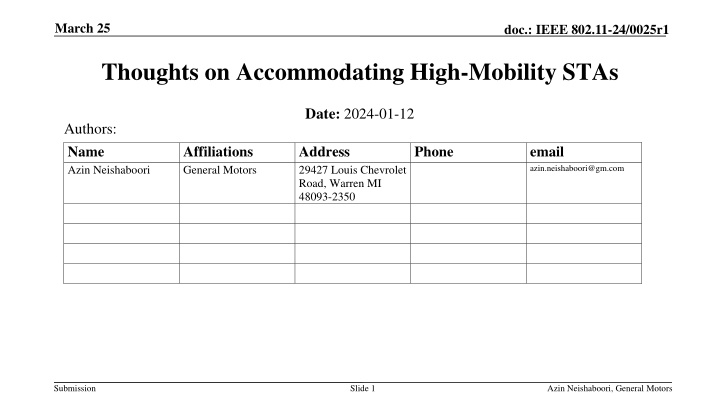
Enhancing Wi-Fi Support for High-Mobility STAs in IEEE 802.11
Explore innovative modifications to IEEE 802.11 standards to accommodate high-mobility STAs for seamless connectivity in the growing Connected Vehicle Market. Learn about proposals to enhance Wi-Fi as a backhaul link for vehicles, improving channel estimation and identifying high-mobility STAs for optimum performance.
Download Presentation

Please find below an Image/Link to download the presentation.
The content on the website is provided AS IS for your information and personal use only. It may not be sold, licensed, or shared on other websites without obtaining consent from the author. If you encounter any issues during the download, it is possible that the publisher has removed the file from their server.
You are allowed to download the files provided on this website for personal or commercial use, subject to the condition that they are used lawfully. All files are the property of their respective owners.
The content on the website is provided AS IS for your information and personal use only. It may not be sold, licensed, or shared on other websites without obtaining consent from the author.
E N D
Presentation Transcript
March 25 doc.: IEEE 802.11-24/0025r1 Thoughts on Accommodating High-Mobility STAs Date: 2024-01-12 Authors: Name Azin Neishaboori Affiliations General Motors Address 29427 Louis Chevrolet Road, Warren MI 48093-2350 Phone email azin.neishaboori@gm.com Submission Slide 1 Azin Neishaboori, General Motors
March 25 doc.: IEEE 802.11-24/0025r1 Abstract Seamless mobility, outlined in UHR PAR [1], requires, among others, a mechanism to ensure reliable connectivity and quality of experience for mobile users In this presentation, we discuss the growing need for Wi-Fi support of (non-AP) STAs in high mobility We propose a modification to PHY to improve rCFO estimation for high- mobility (non-AP) STAs We propose reuse of location track notification mechanism to inform AP of the speed of (non-AP) STAs Submission Slide 2 Azin Neishaboori, General Motors
March 25 doc.: IEEE 802.11-24/0025r1 Motivation The Connected Vehicle Market size is estimated at USD 63.39 billion in 2023, and is expected to reach USD 141.06 billion by 2028, growing at a Compound Annual Growth Rate of 17.35% during the forecast period (2023-2028). (Modor Intelligence) ~94% of DL data is infotainment94% Currently internet connectivity for connected vehicles while in motion is via cellular: Increasingly costly Too taxing for current cellular capacity given the enormous projected data volume If only Wi-Fi could also help as backhaul link for vehicle connectivity during motion Submission Slide 3 Azin Neishaboori, General Motors
March 25 doc.: IEEE 802.11-24/0025r1 Motivation Currently available externally accessible Wi-Fi APs can provide coverage in downtown and even suburb environments if other challenges addressed Several PHY, MAC & higher layer issues need to be addressed to make this possible, but: In this presentation, we only focus on (1) improving rCFO estimation, and (2) high-mobility STAs identification Mid-amble included in 802.11ax to improve channel estimation for outdoor environments with moving scatterers [2-3], but: Implementation support by vendors very limited Lacks in data in proving efficacy for addressing channel estimation accuracy at high-mobility (non-AP) STA with speed > 3 km/h with currently possible configurations Options for mid-amble update interval (No. of data symbols between two mid-ambles): currently 10 and 20 might need to be revisited for STAs of high-mobility Need to use Mid-amble for both CFO & channel estimation In high Doppler, rCFO estimation based on current pilot tones within RUs allocated for STAs with < 3 km/h speed may perform poorly for high-mobility STAs Slide 4 Submission Azin Neishaboori, General Motors
March 25 doc.: IEEE 802.11-24/0025r1 Ultra-Robust Resource Units Proposing an Ultra-Robust RU type for high-mobility STAs: Ultra-Robust RUs have higher number of pilot subcarriers to better track rCFO Number of pilot subcarriers can be selected from a few options based on the (non-AP) STA s velocity and change of direction The set of options could correspond to low (3 km/h < v < 20 km/h), medium (20 km/h < v <50 km/h), and high speed (50 km/h < v < 180 km/h) Ultra-Robust RUs may be rRUs (regular RUs) or dRUs (distributed RUs [4]): For rRUs, this requires new additional pilot tone assignments for RUs of different sizes For dRUs, building on [5] with dRUs with one set of shared pilot tones for all RU sizes: Define a single set of pilot tones to sample the entire frequency band wherein: Non-high mobility STAs could use RUs wherein once every M >1 tones of the superset of possible pilot tones are included in the dRU as pilot tones High-mobility STAs assign Ultra-Robust dRUs wherein once every K tones (K=1, 2, < M) are included in the dRU as pilot tones Submission Slide 5 Azin Neishaboori, General Motors
March 25 doc.: IEEE 802.11-24/0025r1 Thoughts on identifying high-mobility STAs and their speed Use Location Configuration Request/Response and Location Track Notification frames as specified in [6] No new change to 802.11 standard APs serving high-mobility users could send Location Configuration Request High Mobility (non-AP) STAs could respond to the request thereby activating location tracking (which also includes speed data) PHY parameters decided based on motion/speed values received from STA s periodic (at configurable target data rate) location track notification data received by AP STA being tracked sends Location Track Notification frames to the AP which had sent it the Location Configuration Request and potentially all APs in the same ESS The (non-AP) STA will stop sending Location Track Notification frames if it does not hear any beacons from ESS it was configured to send Location Track Notification in Alternative option: Create a new field in Extended Capabilities to indicate AP s capability for handling high-mobility (non-AP) STAs Needs new field and modification to the association process for AP and high-mobility STA Submission Slide 6 Azin Neishaboori, General Motors
March 25 doc.: IEEE 802.11-24/0025r1 Future Studies Assess rCFO for high-mobility (non-AP) STAs Assess rCFO improvement gained by proposed Ultra-Robust RUs Assess rCFO improvement gained by proposed Ultra-Robust RUs + Midamble-enhanced CFO estimation Location Track Notification frames are currently Multicast, creating privacy concerns: revisit this? Submission Slide 7 Azin Neishaboori, General Motors
March 25 doc.: IEEE 802.11-24/0025r1 References [1] 11-23/480r3 UHR draft proposed PAR [2] 11-17/0773r2 Thoughts on Doppler Design in 802.11ax [3] 11-17/0960r0 Follow Up on Doppler Design in 802.11ax [4] 11-23/0037 UHR Feature to Overcome PSD Limitations Distributed-Tone Resource Units [5] 11-23/1516r0 Use case for distributed RUs in Downlink [6] 80211-2020 Submission Slide 8 Azin Neishaboori, General Motors
March 25 doc.: IEEE 802.11-24/0025r1 BACK-UP SLIDES Submission Slide 9 Azin Neishaboori, General Motors
March 25 doc.: IEEE 802.11-24/0025r1 Backup- Location Tracking Details from 802.11-2020 The Broadcast Target Data Rate field specifies the target data rate at which the STA transmits Location Track Notification frames. The Broadcast Target Data Rate field format is specified by the Rate Identification field defined in 9.4.1.32. A Broadcast Target Data Rate field set to 0 indicates the STA transmits Location Track Notification frames at a rate chosen by the STA transmitting the Location Track Notification frames. Submission Slide 10 Azin Neishaboori, General Motors
March 25 doc.: IEEE 802.11-24/0025r1 Backup The Motion subelement field values are valid at the time of transmission of the Location Track Notification frame containing the subelement. 11.21.4.2 d)4) If the Tracking Duration is 0 the STA shall continuously transmit Location Track Notification frames as defined by Normal and In- Motion Report Interval field values until configured to terminate transmission as described 11.21.4.1. Submission Slide 11 Azin Neishaboori, General Motors


